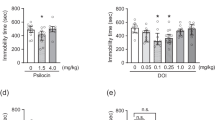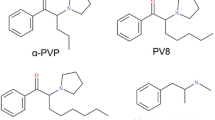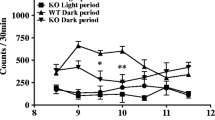Abstract
Background
5-Methoxy-N,N-dimethyltryptamine (5-MeO-DMT) and harmaline are indolealkylamine (IAA) drugs often abused together. Our recent studies have revealed the significant effects of co-administered harmaline, a monoamine oxidase inhibitor (MAOI), on 5-MeO-DMT pharmacokinetics and thermoregulation. This study was to delineate the impact of harmaline and 5-MeO-DMT on home-cage activity in mouse models, as well as the contribution of serotonin (5-HT) receptors.
Methods
Home-cage activities of individual animals were monitored automatically in the home cages following implantation of telemetry transmitters and administration of various doses of IAA drugs and 5-HT receptor antagonists. Area under the effect curve (AUEC) of mouse activity values were calculated by trapezoidal rule.
Results
High dose of harmaline (15 mg/kg, ip) alone caused an early-phase (0–45 min) hypoactivity in mice that was fully attenuated by 5-HT1A receptor antagonist WAY-100635, whereas a late-phase (45–180 min) hyperactivity that was reduced by 5-HT2A receptor antagonist MDL-100907. 5-MeO-DMT (10 and 20 mg/kg, ip) alone induced biphasic effects, an early-phase (0–45 min) hypoactivity that was completely attenuated by WAY-100635, and a late-phase (45–180 min) hyperactivity that was fully suppressed by MDL-100907. Interestingly, co-administration of MAOI harmaline (2–15 mg/kg) with a subthreshold dose of 5-MeO-DMT (2 mg/kg) induced excessive hyperactivities at late phase (45–180 min) that could be abolished by either WAY-100635 or MDL-100907.
Conclusions
Co-administration of MAOI with 5-MeO-DMT provokes excessive late-phase hyperactivity, which involves the activation of both 5-HT1A and 5-HT2A receptors.
Similar content being viewed by others
References
Araujo AM, Carvalho F, Bastos Mde L, Guedes de Pinho P, Carvalho M. The hallucinogenic world of tryptamines: an updated review. Arch Toxicol 2015;89: 1151–73.
Yu AM. Indolealkylamines: biotransformations and potential drug-drug interactions. AAPS J 2008;10:242–53.
Halberstadt AL. Recent advances in the neuropsychopharmacology of serotonergic hallucinogens. Behav Brain Res 2015;277:99–120.
Bruno R, Matthews AJ, Dunn M, Alati R, McIlwraith F, Hickey S, et al. Emerging psychoactive substance use among regular ecstasy users in Australia. Drug Alcohol Depend 2012;124:19–25.
Halberstadt AL, Geyer MA. Multiple receptors contribute to the behavioral effects of indoleamine hallucinogens. Neuropharmacology 2011;61:364–81.
McKenna DJ. Clinical investigations of the therapeutic potential of ayahuasca: rationale and regulatory challenges. Pharmacol Ther 2004;102:111–29.
Winstock AR, Kaar S, Borschmann R. Dimethyltryptamine (DMT): prevalence, user characteristics and abuse liability in a large global sample. J Psychopharmacol 2014;28:49–54.
McIlhenny EH, Riba J, Barbanoj MJ, Strassman R, Barker SA. Methodology for and the determination of the major constituents and metabolites of the Amazonian botanical medicine ayahuasca in human urine. Biomed Chromatogr 2011;25:970–84.
Dea, DoJ. Schedules of controlled substances: placement of 5-methoxy-N,N-dimethyltryptamine into Schedule I of the Controlled Substances Act. Final rule. Fed Regist 2010;75:79296–300.
Dea, DoJ. Schedules of controlled substances: placement of alpha-methyltryptamine and 5-methoxy-N,N-diisopropyltryptamine into schedule I of the Controlled Substances Act. Final rule. Fed Regist 2004;69:58950–53.
Brush DE, Bird SB, Boyer EW. Monoamine oxidase inhibitor poisoning resulting from Internet misinformation on illicit substances. J Toxicol Clin Toxicol 2004;42:191–5.
Long H, Nelson LS, Hoffman RS. Alpha-methyltryptamine revisited via easy Internet access. Vet Hum Toxicol 2003;45:149.
Muller AA. New drugs of abuse update: foxy Methoxy. J Emerg Nurs 2004;30:507–8.
Sklerov J, Levine B, Moore KA, King T, Fowler D. A fatal intoxication following the ingestion of 5-methoxy-N,N-dimethyltryptamine in an ayahuasca preparation. J Anal Toxicol 2005;29:838–41.
Smolinske SC, Rastogi R, Schenkel S. Foxy methoxy: a new drug of abuse. J Med Toxicol 2005;1:22–5.
Tanaka E, Kamata T, Katagi M, Tsuchihashi H, Honda K. A fatal poisoning with 5-methoxy-N,N-diisopropyltryptamine, Foxy. Forensic Sci Int 2006;163: 152–154.
Hill SL, Thomas SH. Clinical toxicology of newer recreational drugs. Clin Toxicol (Phila) 2011;49:705–19.
Bjornstad K, Hulten P, Beck O, Helander A. Bioanalytical and clinical evaluation of 103 suspected cases of intoxications with psychoactive plant materials. Clin Toxicol (Phila) 2009;47:566–72.
Fuse-Nagase Y, Nishikawa T. Prolonged delusional state triggered by repeated ingestion of aromatic liquid in a past 5-methoxy-N,N-diisopropyltryptamine abuser. Addict Sci Clin Pract 2013;8:9.
Ott J. Pharmepena-psychonautics: human intranasal, sublingual and oral pharmacology of 5-methoxy-N,N-dimethyl-tryptamine. J Psychoact Drugs 2001;33:403–7.
Jiang XL, Shen HW, Mager DE, Yu AM. Pharmacokinetic interactions between monoamine oxidase A inhibitor harmaline and 5-methoxy-N,N-dimethyltryptamine, and the impact of CYP2D6 status. Drug Metab Dispos 2013;41: 975–986.
Shen HW, Jiang XL, Yu AM. Development of a LC-MS/MS method to analyze 5-methoxy-N,N-dimethyltryptamine and bufotenine, and application to pharmacokinetic study. Bioanalysis 2009;1:87–95.
Shen HW, Wu C, Jiang XL, Yu AM. Effects of monoamine oxidase inhibitor and cytochrome P450 2D6 status on 5-methoxy-N,N-dimethyltryptamine metabolism and pharmacokinetics. Biochem Pharmacol 2010;80:122–8.
Shen HW, Jiang XL, Winter JC, Yu AM. Psychedelic 5-methoxy-N,N-dimethyltryptamine: metabolism, pharmacokinetics, drug interactions, and pharmacological actions. Curr Drug Metab 2010;11:659–66.
Cheng J, Zhen Y, Miksys S, Beyoglu D, Krausz KW, Tyndale RF, et al. Potential role of CYP2D6 in the central nervous system. Xenobiotica 2013;43: 973–984.
Halberstadt AL, Buell MR, Masten VL, Risbrough VB, Geyer MA. Modification of the effects of 5-methoxy-N,N-dimethyltryptamine on exploratory behavior in rats by monoamine oxidase inhibitors. Psychopharmacology (Berl) 2008;201: 55–66.
Winter JC, Amorosi DJ, Rice KC, Cheng K, Yu AM. Stimulus control by 5-methoxy-N,N-dimethyltryptamine in wild-type and CYP2D6-humanized mice. Pharmacol Biochem Behav 2011;99:311–5.
Jiang XL, Shen HW, Yu AM. Potentiation of 5-methoxy-N,N-dimethyltryptamine-induced hyperthermia by harmaline and the involvement of activation of 5-HT1A and 5-HT2A receptors. Neuropharmacology 2015;89:342–51.
Halberstadt AL, Nichols DE, Geyer MA. Behavioral effects of alpha,alpha,beta,-beta-tetradeutero-5-MeO-DMT in rats: comparison with 5-MeO-DMT administered in combination with a monoamine oxidase inhibitor. Psychopharmacology (Berl) 2012;221:709–18.
Winter JC, Filipink RA, Timineri D, Helsley SE, Rabin RA. The paradox of 5-methoxy-N,N-dimethyltryptamine: an indoleamine hallucinogen that induces stimulus control via 5-HT1A receptors. Pharmacol Biochem Behav 2000;65:75–82.
Riga MS, Soria G, Tudela R, Artigas F, Celada P. The natural hallucinogen 5-MeO-DMT, component of Ayahuasca, disrupts cortical function in rats: reversal by antipsychotic drugs. Int J Neuropsychopharmacol 2014;17:1269–82.
van den Buuse M, Ruimschotel E, Martin S, Risbrough VB, Halberstadt AL. Enhanced effects of amphetamine but reduced effects of the hallucinogen, 5-MeO-DMT, on locomotor activity in 5-HT(1A) receptor knockout mice: implications for schizophrenia. Neuropharmacology 2011;61:209–16.
Halberstadt AL, Koedood L, Powell SB, Geyer MA. Differential contributions of serotonin receptors to the behavioral effects of indoleamine hallucinogens in mice. J Psychopharmacol 2011;25:1548–61.
Roth BL, Choudhary MS, Khan N, Uluer AZ. High-affinity agonist binding is not sufficient for agonist efficacy at 5-hydroxytryptamine2A receptors: evidence in favor of a modified ternary complex model. J Pharmacol Exp Ther 1997;280:576–83.
Haberzettl R, Bert B, Fink H, Fox MA. Animal models of the serotonin syndrome: a systematic review. Behav Brain Res 2013;256C:328–45.
Boyer EW, Shannon M. The serotonin syndrome. N Engl J Med 2005;352:1112–20.
Kant S, Liebelt E. Recognizing serotonin toxicity in the pediatric emergency department. Pediatr Emerg Care 2012;28:817–21. quiz 22-24.
Kassai F, Kedves R, Gyertyan I, Tuka B, Fulop F, Toldi J, et al. Effect of a kynurenic acid analog on home-cage activity and body temperature in rats. Pharmacol Rep 2015;67:1188–92.
Gelzer AR, Ball HA. Validation of a telemetry system for measurement of blood pressure, electrocardiogram and locomotor activity in beagle dogs. Clin Exp Hypertens 1997;19:1135–60.
Vivanco P, Studholme KM, Morin LP. Drugs that prevent mouse sleep also block light-induced locomotor suppression, circadian rhythm phase shifts and the drop in core temperature. Neuroscience 2013;254:98–109.
Ossowska K, Wardas J, Berghauzen-Maciejewska K, Glowacka U, Kuter K, Pilc A, et al. Lu AF21934, a positive allosteric modulator of mGlu4 receptors, reduces the harmaline-induced hyperactivity but not tremor in rats. Neuropharmacology 2014;83:28–35.
Nasehi M, Jamshidi-Mehr M, Khakpai F, Zarrindast MR. Possible involvement of CA1 5-HT1B/1D and 5-HT2A/2B/2C receptors in harmaline-induced amnesia. Pharmacol Biochem Behav 2014;125:70–7.
Ossowska K, Glowacka U, Kosmowska B, Wardas J. Apomorphine enhances harmaline-induced tremor in rats. Pharmacol Rep 2015;67:435–41.
Abdel-Fattah AF, Matsumoto K, Gammaz HA, Watanabe H. Hypothermic effect of harmala alkaloid in rats: involvement of serotonergic mechanism. Pharmacol Biochem Behav 1995;52:421–6.
Spencer Jr. DG, Glaser T, Traber J. Serotonin receptor subtype mediation of the interoceptive discriminative stimuli induced by 5-methoxy-N,N-dimethyltryptamine. Psychopharmacology (Berl) 1987;93:158–66.
Abdel-Fattah AF, Matsumoto K, Murakami Y, Adel-Khalek Gammaz H, Mohamed MF, Watanabe H. Central serotonin level-dependent changes in body temperature following administration of tryptophan to pargyline- and harmaline-pretreated rats. Gen Pharmacol 1997;28:405–9.
Krebs-Thomson K, Ruiz EM, Masten V, Buell M, Geyer MA. The roles of 5-HT1A and 5-HT2 receptors in the effects of 5-MeO-DMT on locomotor activity and prepulse inhibition in rats. Psychopharmacology (Berl) 2006;189:319–29.
Mittman SM, Geyer MA. Dissociation of multiple effects of acute LSD on exploratory behavior in rats by ritanserin and propranolol. Psychopharmacology (Berl) 1991;105:69–76.
Palenicek T, Balikova M, Bubenikova-Valesova V, Horacek J. Mescaline effects on rat behavior and its time profile in serum and brain tissue after a single subcutaneous dose. Psychopharmacology (Berl) 2008;196:51–62.
Yu AM, Idle JR, Herraiz T, Kupfer A, Gonzalez FJ. Screening for endogenous substrates reveals that CYP2D6 is a 5-methoxyindolethylamine O-demethylase. Pharmacogenetics 2003;13:307–19.
Yu AM, Idle JR, Krausz KW, Kupfer A, Gonzalez FJ. Contribution of individual cytochrome P450 isozymes to the O-demethylation of the psychotropic beta-carboline alkaloids harmaline and harmine. J Pharmacol Exp Ther 2003;305: 315–22.
Wu C, Jiang XL, Shen HW, Yu AM. Effects of CYP2D6 status on harmaline metabolism, pharmacokinetics and pharmacodynamics, and a pharmacogenetics-based pharmacokinetic model. Biochem Pharmacol 2009;78:617–24.
Author information
Authors and Affiliations
Corresponding author
Rights and permissions
About this article
Cite this article
Jiang, XL., Shen, HW. & Yu, AM. Modification of 5-methoxy-N, N-dimethyltryptamine-induced hyperactivity by monoamine oxidase A inhibitor harmaline in mice and the underlying serotonergic mechanisms. Pharmacol. Rep 68, 608–615 (2016). https://doi.org/10.1016/j.pharep.2016.01.008
Received:
Revised:
Accepted:
Published:
Issue Date:
DOI: https://doi.org/10.1016/j.pharep.2016.01.008




